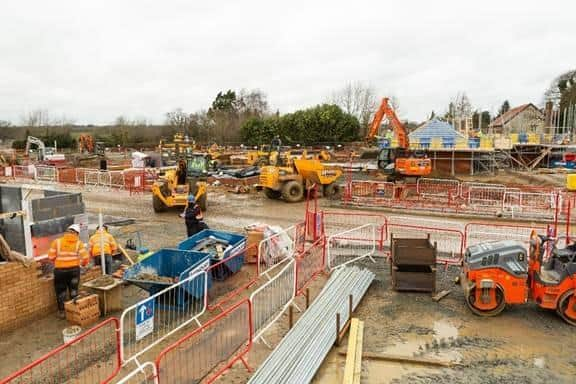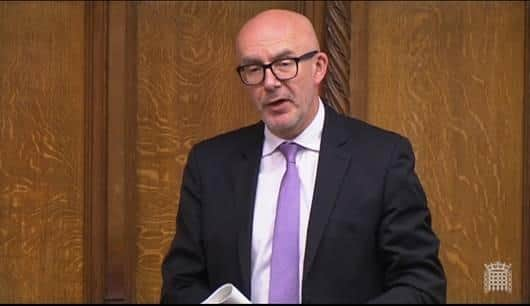'12,000 homes could be needlessly built in and around our towns' says Warwick and Leamington MP
and live on Freeview channel 276
Warwick and Leamington MP Matt Western has warned that as many as 12,000 homes could be 'needlessly' built in and around the Warwick district.
Research by planning expert Ray Bullen shows 20,700 homes are to be built in the area by 2029, around 4,000 more than outlined in Warwick District Council’s (WDC) housebuilding plans.
Advertisement
Hide AdAdvertisement
Hide AdBut a more accurate number of homes needed in the district in the same time frame could be as low as 8,500, demographer Merle Gering estimates.


Mr Western has called for an immediate review of regional plans for housebuilding – and a suspension on construction of already approved developments.
He fears the surplus homes would ‘damage communities’ and change parts of his constituency ‘beyond recognition’.
Warwick District Council (WDC) adopted its Local Plan for housing in 2017 and it outlines the need for 16,776 homes to be built between 2011 and 2029 to satisfy statutory requirements.
Advertisement
Hide AdAdvertisement
Hide AdIncluded within the plan are 6,000 homes which cater to neighbouring Coventry’s housing need that cannot be achieved within the city’s boundaries - often referred to as ‘overspill’.


But analysis by experienced ex-council planner and architect Mr Bullen shows, at the current trajectory of applications granted and sites earmarked for development, 20,751 new homes will be built in the district by 2029.
Mr Gering, who is also chairman of campaign group Keep Our Greenbelt Green, told Mr Western the census data shows the actual population growth in the area between 2011 and 2021 has been around 10,000 less than forecasted in the Local Plan.
He says housing delivery in Warwick district over the last decade - 6,482 homes (or 648 per year) - has more than provided for the real increase in population of 10,852 people.
Advertisement
Hide AdAdvertisement
Hide AdHe claims a more accurate estimate for homes needed between 2011 and 2029, based on census data such as population and household occupancy rates, is around 8,354.


Mr Western said: “I commend Mr Gering’s research, which has confirmed my fears that thousands of homes should be deleted from the Local Plan.
“These unnecessary homes will damage our environment and beautiful countryside - and impact on much needed farmland we need for food security.
“Plus, hardly any of the homes outlined in the plan are social rent or council homes.
Advertisement
Hide AdAdvertisement
Hide Ad“WDC must lobby Coventry City Council (CCC) and the Government for alternative, updated statistics to be used – and announce a moratorium for existing applications that could have been accepted based on faulty numbers.”
Mr Gering predicts fewer homes will be needed across the region as less than half of the 42,000 homes earmarked in Coventry’s own Local Plan are required, because existing data fails to account for departing students – also relegating the need for overspill into other districts.
The latest Office for National Statistics (ONS) population forecasts are 40,000 higher for Coventry than actual growth shown in the census – one of most notable overestimations in the country.
CCC has admitted the ONS data is ‘flawed’ but says the homes earmarked in its Local Plan are still required, the BBC reported.
Advertisement
Hide AdAdvertisement
Hide AdBut councillors have agreed to review the plans and challenge the Government on the data at the end of the year.
Mr Gering said: “I have huge sympathy for the people of Warwick district who are having thousands of homes forced upon them unnecessarily.
“We need to suspend Local Plans in the region until they are based on reliable data.”
An ONS spokesperson in The Guardian suggested estimates would be ‘rebased’ and reviewed in line with updated census data.
Advertisement
Hide AdAdvertisement
Hide AdThe ONS is investigating the concerns that have been raised about the accuracy of the housing forecasts for Coventry.
These investigations will also address the knock-on implication for the number of 'overspill' houses Warwick District has been required to meet.
Cllr Andrew Day, the leader of WDC, said: “We await the outcome of the ONS investigation, with interest.
“Our Local Plan was adopted in 2017 following a rigorous process, including an examination in public led by an independent Inspector.
Advertisement
Hide AdAdvertisement
Hide Ad"The plan allows for 600 new homes on average each year to meet the district’s own housing needs, and an additional 332 new homes a year to meet part of Coventry's housing need, with other Districts taking their share of the 'overspill' too.
"Although some of the sites allocated in our current Local Plan haven’t yet been granted planning permission, the majority now have.
"These include major housing developments at The Asps and part of the land at King's Hill, as well as much of the land east of Kenilworth and south of Warwick and Leamington.
"Work is also well underway to progress planning applications for some of the remaining housing sites allocated in the Local Plan but have not yet been given consent.
Advertisement
Hide AdAdvertisement
Hide Ad“The publication at the end of June of the initial findings from the 2021 census also provides an important and welcome opportunity to use the most up to date data to understand how many local homes we will need to provide through to 2050, as part of the new South Warwickshire Local Plan.
“We are working with the other Warwickshire councils across the sub-region to commission a major study to give us a proper and up to date understanding of likely levels of housing and economic development needed as we prepare this new Local Plan.
"Importantly, this study called a Housing and Economic Development Needs Assessment (HENDA) will use the new census data as its starting point to give us the best possible understanding of housing needs within the sub-region, and specifically for our local area.
"The HEDNA will be published this autumn and will inform the next Issues and options report, which we hope to be able to put out for consultation before the end of the year so everyone can review the numbers and have their say on the calculations.
